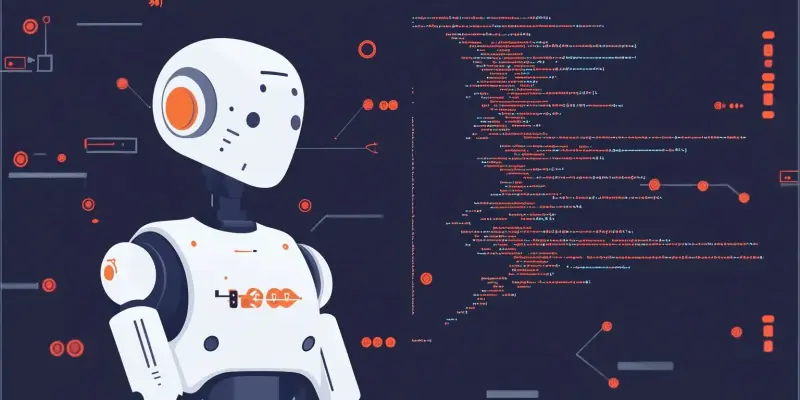The rapid progression of artificial intelligence (AI) has been significantly driven by the vibrant open-source community, which consistently provides innovative tools for developers. By 2025, AI has advanced considerably, with a variety of powerful open-source libraries available to assist engineers and researchers in developing sophisticated solutions across various domains like machine learning, natural language processing (NLP), and computer vision. Key libraries include TensorFlow, PyTorch, Hugging Face Transformers, OpenCV, Scikit-learn, JAX, and FastAI, each offering specialized capabilities essential for modern AI development.
Major Libraries in AI Development
TensorFlow and PyTorch: Dominators of Machine Learning
TensorFlow, supported by Google, has cemented its place as a prime choice for machine learning and neural network tasks. It continues to evolve, offering developers new tools and optimizations that significantly enhance performance and usability. TensorFlow’s comprehensive ecosystem includes TensorFlow Lite for mobile deployment and TensorFlow Extended for end-to-end machine learning pipeline management. This has made it indispensable for creating robust, scalable ML applications.
Meanwhile, PyTorch, developed by Meta, maintains its dominance in AI research due to its dynamic computation graph and user-friendliness. It caters to researchers who need flexibility and immediate feedback on their experiments. The recent release of PyTorch 2.5 features enhanced distributed training on next-generation GPUs, aiding researchers in managing larger datasets and models. This capability is critical as data-intensive AI projects continue to grow, necessitating efficient data handling and processing methods.
Hugging Face Transformers: Revolutionizing NLP and Beyond
Hugging Face Transformers has been a game-changer in the NLP field by providing easily accessible pre-trained models for various language tasks. These models have democratized NLP by allowing developers and researchers to leverage state-of-the-art models without deep dives into the underlying complex architectures. By 2025, Hugging Face expanded its horizons, supporting multimodal models integrating text, vision, and audio data. This expansion has proven particularly valuable in tasks requiring a synthesis of multi-source information.
The library’s user-friendly interface and extensive documentation make it an indispensable tool for AI developers. With numerous pre-trained models available, including those for translation, sentiment analysis, and text generation, Hugging Face enables rapid prototyping and deployment of NLP applications. Moreover, its continuous updates ensure that the latest advancements in NLP research are quickly made available to the community, fostering a cycle of innovation and powerful tool development.
Key Advancements in AI Libraries
OpenCV: The Backbone of Computer Vision
OpenCV remains essential for computer vision aficionados, thanks to its comprehensive suite of tools for image and video analysis. The library has introduced state-of-the-art features for 3D reconstruction, real-time object tracking, and AI-enhanced video editing in its 2024 update. These advancements have broadened the scope of computer vision applications, from simple image recognition tasks to sophisticated visual data processing required in fields such as robotics, augmented reality, and autonomous vehicles.
Compatibility with TensorFlow and PyTorch simplifies incorporating machine learning into vision projects, making OpenCV a versatile tool for diverse AI applications. The library’s extensive functionality and continuous improvements ensure it keeps pace with the rapidly evolving AI landscape, maintaining its status as a cornerstone for computer vision development. Its widespread adoption and robust community support further reinforce its role as an indispensable resource for developers worldwide.
Scikit-learn and JAX: Driving Machine Learning Efficiency
Scikit-learn remains a staple for traditional machine learning due to its simplicity and efficiency. The incorporation of automated machine learning (AutoML) functionalities in recent updates reduces human involvement in model building, making it accessible to non-experts. This development is crucial as it enables a broader audience to harness the power of machine learning, expanding the potential for innovation across various industries.
Its interoperability with libraries like Pandas and NumPy ensures Scikit-learn remains a robust choice for data preprocessing and model evaluation. On the other hand, JAX has gained traction for its accelerated computation and deep learning support, particularly with seamless GPU and TPU integration. By 2025, JAX supports distributed computing and advanced optimization techniques, positioning it as a formidable contender in the AI space, with capabilities that cater to the increasing complexity and scale of modern AI applications.
Democratizing AI Development
FastAI: Making AI Accessible to Everyone
FastAI’s mission of democratizing AI has made significant strides by providing a high-level abstraction for deep learning tasks. This approach lowers the barrier to entry, making AI accessible for both beginners and seasoned practitioners. The library’s latest version enhances usability and speed in prototyping for computer vision, text analysis, and tabular data projects, ensuring that users can quickly iterate and refine their models.
FastAI enables rapid development by abstracting complex processes, allowing developers to focus on application-specific challenges rather than getting bogged down by technical intricacies. This has fostered a more inclusive AI community where innovation is driven by a diverse group of contributors. FastAI’s open-source nature and supportive community have been instrumental in building a collaborative environment, pushing the boundaries of what’s possible in AI.
The Future of Open-Source AI Libraries
The rapid advancement of artificial intelligence (AI) has been significantly propelled by the dynamic open-source community, which continually offers innovative tools for developers. By 2025, AI has made remarkable strides, with a vast array of potent open-source libraries accessible to assist engineers and researchers in creating sophisticated solutions in various fields such as machine learning, natural language processing (NLP), and computer vision. Prominent libraries include TensorFlow, PyTorch, Hugging Face Transformers, OpenCV, Scikit-learn, JAX, and FastAI. Each of these tools provides unique and specialized capabilities that are crucial for state-of-the-art AI development.
TensorFlow and PyTorch have been particularly instrumental in machine learning, providing robust frameworks for creating and training neural networks. Hugging Face Transformers have revolutionized NLP by offering pre-trained models that simplify complex tasks. OpenCV remains essential for image and video processing, while Scikit-learn is invaluable for data mining and analysis. JAX brings accelerated computing, and FastAI simplifies the training of deep learning models, making these libraries indispensable in the modern AI landscape.

